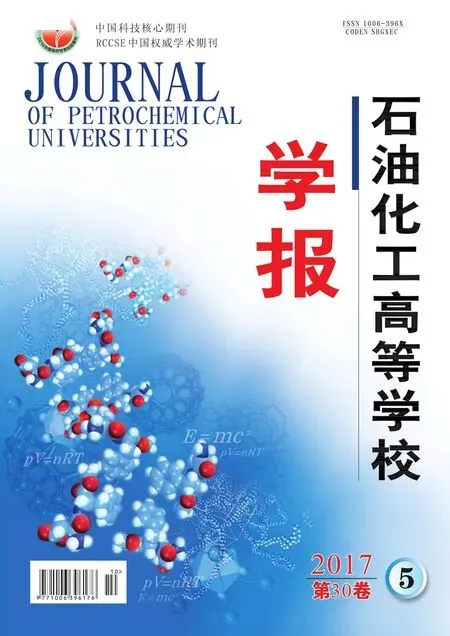CH-90交换树脂对废水中Co2+、Mn2+的去除
史学伟, 吴艳阳, 徐首红, 赵双良
(1.华东理工大学 化学与分子工程学院,上海 200237; 2.华东理工大学 化工学院, 上海 200237)
CH-90交换树脂对废水中Co2+、Mn2+的去除
史学伟1,2, 吴艳阳2, 徐首红1, 赵双良2
(1.华东理工大学 化学与分子工程学院,上海 200237; 2.华东理工大学 化工学院, 上海 200237)
研究了CH-90阳离子交换树脂对PTA模拟废水及工业废水中Co2+、 Mn2+的吸附性能,考察了不同pH、CH-90树脂的质量浓度、接触时间对树脂吸附性能的影响。结果表明,当pH=3.5、CH-90树脂的质量浓度为2.0 g/L时,CH-90树脂对模拟废水中Co2+、 Mn2+去除率达到最佳,最大吸附量分别为55.4、50.5 mg/g,其吸附过程符合准二级动力学描述。而在工业废水中,由于有机物的大量存在及pH的影响,最合适的CH-90树脂的质量浓度为24 g/L。吸附后的树脂在强酸中脱附,能够重复再生15次以上,降低树脂的使用成本。
Co2+; Mn2+; 离子交换树脂; 废水处理
本文主要研究CH-90阳离子交换树脂对PTA废水中Co2+、Mn2+的吸附性能,考察废水pH、CH-90树脂的质量浓度、吸附时间等参数对吸附性能的影响,并研究脱附条件与重复使用效率。
1 实验部分
1.1试剂及仪器
试剂:CH-90阳离子交换树脂(科海思北京科技有限公司);六水合氯化钴、六水合氯化锰、盐酸、氢氧化钠、无水乙醇(AR,国药集团试剂有限公司)。
仪器:Agilent 725ES型全谱直读等离子体发射光谱(Agilent 公司);AB204-N型电子天平(上海梅特勒-托利多有限公司);真空干燥箱(上海华连医疗器械有限公司);DF-101S 集热式恒温加热磁力搅拌器(上海远怀化工科技有限公司);AB204-N型精密酸度计(赛多利斯科学仪器公司)。
1.2吸附实验
1.2.1 pH影响 分别配置6组体积为100 mL初始质量浓度为80 mg/L的氯化钴、氯化锰溶液,加入到150 mL锥形瓶中,然后每组分别加入0.2 g CH-90树脂,调节pH从1到6,温度控制在25 ℃,反应时间24 h,最后取样,离心,检测残余金属溶液质量浓度。
1.2.2 CH-90树脂质量浓度的影响 按上述方法分别配置氯化钴和氯化锰溶液8组,每组分别加入CH-90树脂0.02、0.05、0.10、0.20、0.40、0.60、0.80、1.00 g ,温度控制在25 ℃,pH调节至3.5,反应时间24 h,最后取样,离心,检测残余金属溶液浓度。
1.2.3 吸附动力学 按上述方法分别配置氯化钴和氯化锰溶液一组,每组加入0.2 g CH-90树脂,温度控制在25 ℃,pH调节至3.5,然后按时间间隔取样,离心,检测残余金属溶液浓度,金属离子吸附量qt和去除率R计算公式见式(1)、(2):
其中,qt为金属离子吸附量,mg/g;ρ0为Co2+、 Mn2+溶液的初始质量浓度,mg/L ;ρt为Co2+、 Mn2+溶液的平衡质量浓度,mg/L;V为溶液的体积,L;m为CH-90树脂的质量,g;R为金属离子去除率。
2 结果与讨论
2.1模拟废水
2.1.1 酸性溶液pH的影响 图1为pH对CH-90树脂吸附Co2+、 Mn2+性能的影响。Co2+、 Mn2+的初始质量浓度为80 mg/L,CH-90树脂质量浓度为2.0 g/L,搅拌时间为12 h。由图1可见,当pH很低时,吸附剂对金属离子的吸附效果很差,当pH为1时,基本不吸附。因为溶液中H+浓度大,它与Co2+、 Mn2+产生竞争作用,争夺在吸附剂上的活性位点,使CH-90树脂对Co2+、 Mn2+的吸附作用减弱[16]。对于Co2+,pH为3.5时吸附效果最好,而 pH为4时对Mn2+的吸附效果最好,后续实验pH都取3.5。

图1 pH对CH-90树脂吸附Co2+ 、Mn2+的影响
Fig.1TheeffectofpHvalueontheadsorptionofCo2+,Mn2+withCH-90resininsimulatedwastewater
2.1.2 CH-90质量浓度的影响 图2是在不同质量浓度下的CH-90树脂对Co2+、Mn2+的吸附曲线。Co2+、 Mn2+的初始质量浓度为80 mg/L,pH为3.5,搅拌时间为12 h。

图2 CH-90树脂质量浓度对吸附Co2+、Mn2+的影响
Fig.2TheeffectofresindosageontheadsorptionofCo2+,Mn2+insimulatedwastewater
由图2可知,当CH-90质量浓度从0.2 g/L增加到2.0 g/L时,吸附剂对Co2+、 Mn2+吸附效果不断增加,因为随着投料量的增加,树脂吸附位点增多,有利于吸附。但再增加树脂的质量时吸附效果并不明显,取2.0 g/L进行后续研究。
2.1.3 吸附时间的影响 Co2+、 Mn2+的初始质量浓度为80 mg/L,pH为3.5,CH-90树脂质量浓度为2.0 g/L,考察反应时间对吸附的影响,结果见图3。图3显示,60 min内曲线很陡峭,Co2+、Mn2+的去除率最高达到80%以上;在60 min以后,曲线慢慢变平缓,在180 min以后达到平衡。说明CH-90树脂对两种金属离子吸附效果很好。

图3 吸附时间对CH-90树脂吸附模拟废水中Co2+、 Mn2+的影响
Fig.3TheeffectofcontacttimeontheadsorptionofCo2+,Mn2+insimulatedwastewater
2.1.4 吸附动力学 吸附动力学提供了金属离子被吸附到吸附剂上的吸附速率常数,并且描述了吸附控制机理。为了获得相关参数,用拟一级动力学和拟二级动力学方程研究Co2+、 Mn2+吸附到CH-90树脂的反应过程。
拟一级动力学方程如式(3)所示:
拟二级动力学方程如式(4)所示:
式中,qt为时间t时的吸附量,mg/g;qe为平衡吸附量,mg/g;k1为拟一级速率吸附常数,min-1;k2为拟二级速率常数,g/(mg·min)。
图4是CH-90树脂对Co2+、Mn2+吸附的拟二级动力学曲线。CH-90树脂对Co2+、Mn2+吸附动力学参数见表1。
由表1可知,Co2+、Mn2+中的准一级动力学模型相关拟合系数比准二级动力学模型中的相关拟合系数要小,尽管对于 Mn2+来说两者相近,但准二级动力学方程中qe,cal更接近实验所得的平衡吸附量qe,exp,所以CH-90树脂对Co2+、 Mn2+的吸附符合准二级动力学方程[17]。

图4 CH-90树脂对Co2+、Mn2+吸附的拟二级动力学曲线Fig.4 Pseudo-second-order kinetic model for adsorptionof Co2+,Mn2+ on the CH-90 resin

方程参数数值Co2+Mn2+拟一级动力学qe,exp/(mg·g-1)4040qe.cal/(mg·g-1)32.2426.67k1/(min-1)0.0410.021R20.93900.9979拟二级动力学qe.cal/(mg·g-1)42.0243.29k2/[(g·/(mg·min)-1]3.046×10-31.281×10-3R20.99870.9989
2.1.5 初始质量浓度对吸附的影响 图5是pH为3.5,CH-90树脂质量浓度为2.0 g/L,搅拌时间为12 h,Co2+、Mn2+不同初始质量浓度时,CH-90对两种金属离子的吸附情况。由图5可知,随着Co2+、Mn2+初始质量浓度的增加,CH-90对Co2+、Mn2+的吸附量逐渐增大,对Co2+的最大吸附量为55.4 mg/g,Mn2+为50.5 mg/g。

图5 初始质量浓度对CH-90吸附模拟废水中Co2+、Mn2+的影响Fig.5 The effect of initial mass concentration on theadsorption of Co2+,Mn2+ in simulated wastewater
2.1.6 脱附-再生实验 把吸附Co2+、Mn2+的CH-90树脂加入到0.1 mol/L的盐酸溶液中进行脱附,脱附时间为2 h,结果见表2。由表2可知,经过15次吸附-脱附循环CH-90树脂吸附效率仍接近100%,说明CH-90树脂再生能力非常好。而后续再产生的含Co2+、Mn2+的盐酸废水集中在小范围容器中,可以使用中和沉淀法使其沉淀。

表2 CH-90吸附Co2+、Mn2+重复实验Table 2 The repeated test on the adsorption of Co2+,Mn2+ with the CH-90 resin
2.2工业废水
表3是某石化工厂PTA生产线上重金属废水的主要组成成分,其pH在4.5~6.5。图6是CH-90树脂在不同质量浓度下对真实工业废水的吸附曲线。当CH-90树脂质量浓度为24 g/L时,能够完全去除PTA废水溶液中的Co2+。

表3 工业废水主要组成Table 3 Main composition of the industrial wastewater
图7是CH-90树脂不同质量浓度条件下对Co2+吸附动力学曲线。由图7可知,当CH-90树脂质量浓度为24 g/L,吸附时间为20 min时,去除率达到76%,而后曲线逐渐平缓至平衡。相比模拟废水,处理工业废水所需CH-90树脂是前者的12倍,原因可能是工业废水中含有许多有机物、杂质、其他重金属,会影响到CH-90树脂对Co2+的吸附过程[18]。此外,工业废水的pH不利于树脂发挥最佳吸附性能。

图6 CH-90质量浓度对吸附Co2+影响
Fig.6TheeffectofresindosageontheadsorptionofCo2+fromtheindustrialwastewater

图7 CH-90树脂吸附Co2+吸附动力学曲线
Fig.7TheeffectofcontacttimeontheadsorptionofCo2+fromtheindustrialwaterwithdifferentresindosages
3 结论
使用CH-90树脂对PTA模拟废水和工业废水中的Co2+、 Mn2+进行吸附研究,CH-90树脂作为一种金属离子吸附剂表现出了良好的吸附性能。研究了pH、CH-90质量浓度及接触时间对吸附性能的影响。结果表明,在pH为3.5、CH-90质量浓度为2.0 g/L时能最大地去除模拟废水中的Co2+、Mn2+重金属离子,且相应的最大吸附量为55.4、50.5 mg/g,其吸附过程符合准二级动力学方程。而处理工业PTA废水时,由于有机物含量及pH较高等因素,CH-90质量浓度达到了24 g/L。树脂在酸性条件下能重复再生15次以上,大幅降低使用成本。
[1] Unuabonah E I, Olu-Owolabi B I, Taubert A, et al. SAPK: A novel composite resin for water treatment with very high Zn2+, Cd2+, and Pb2+adsorption capacity [J]. Industrial & Engineering Chemistry Research, 2013,52(2): 578-585.
[2] Xiong C, Jia Q, Chen X Y, et al. Optimization of polyacrylonitrile-2-aminothiazole resin synthesis, characterization, and its adsorption performance and mechanism for removal of Hg(II) from aqueous solutions[J]. Industrial & Engineering Chemistry Research, 2013,52(14): 4978-4986.
[3] Mandal B K,Suzuki K T. Arsenic round the world: A review[J]. Talanta, 2002, 58(1): 201-235.
[4] 赵会玲,付林伟,赵会艳,等. 氨基树脂微球的表面改性及对水中Co2+的吸附性能研究[J]. 离子交换与吸附, 2016, 32(2): 97-107.
Zhao Huiling, Fu Linwei, Zhao Huiyan,et al. Surface modification of amino-resin particles and its adsorption performance of Co2+from simulated wastewater[J].Ion Exchange and Adsorption, 2016, 32(2): 97-107.
[5] Liu W, Yin P, Liu X G, et al. Thermodynamics, kinetics, and isotherms studies for gold (III) adsorption using silica functionalized by diethylenetriaminemethy lenephosphonic acid[J]. Chemical Engineering Research and Design, 2013,91(12): 2748-2758.
[6] Radi S, Tighadouini S, El Massaoudi M, et al. Thermodynamics and kinetics of heavy metals adsorption on silica particles chemically modified by conjugated β-Ketoenol furan[J]. Journal of Chemical & Engineering Data, 2015,60(10): 2915-2925.
[7] Ku Y, Jung I L. Photocatalytic reduction of Cr (VI) in aqueous solutions by UV irradiation with the presence of titanium dioxide[J]. Water Research, 2001,35(1): 135-142.
[8] Huisman J L, Schouten G, Schultz C. Biologically produced sulphide for purification of process streams, effluent treatment and recovery of metals in the metal and mining industry[J]. Hydrometallurgy, 2006(83): 106-113.
[9] Abbas I, Shamseddine H, Hammud H H. Diethyl ether-modified calix[4]pyrrole receptor: thermodynamics of lead cation complexation-lead extraction from water by its polymer[J]. Complex Metals, 2014,1(1): 57-68.
[10] Lin H J, Xie K, Mahendran B, et al. Sludge properties and their effects on membrane fouling in submerged anaerobic membrane bioreactors (SAnMBRs) [J]. Water Research, 2009, 43(15): 3827-3837.
[11] Figoli A, Cassano A, Criscuoli A, et al. Influence of operating parameters on the arsenic removal by nanofiltration[J]. Water Research, 2010,44(1): 97-104.
[12] Monier M, Ayad D M, Wei Y, et al. Preparation and characterization of magnetic chelating resin based on chitosan for adsorption of Cu(II), Co(II), and Ni(II) ions[J]. Reactive and Functional Polymers, 2010,70(4): 257-266.
[13] Evans J R, Davids W G, Macrae J G, et al. Kinetics of cadmium uptake by chitosan-based crab shells[J]. Water Research, 2002,36(13): 3219-3226.
[14] Rengaraj S, Yeon J W, Kim Y, et al. Adsorption characteristics of Cu(II) onto ion exchange resins 252H and 1500H: kinetics, isotherms and error analysis[J]. Journal of Hazardous Matercals, 2007,143(1): 469-77.
[15] Fu L, Shi X, Zhao H, et al. Two chelating polymeric beads and their adsorption properties toward trace Co (II) from waters[J]. Journal of Multidisciplinary Engineering Science and Technology, 2015, 2(8):2252-2259
[16] Emik S. Preparation and characterization of an IPN type chelating resin containing amino and carboxyl groups for removal of Cu(II) from aqueous solutions[J]. Reactive and Functional Polymers, 2014(75): 63-74.
[17] Nomngongo P N, Ngila J C, Msagati T A M, et al. Kinetics and equilibrium studies for the removal of cobalt, manganese, and silver in ethanol using dowex 50W-x8 cation exchange resin[J]. Separation Science and Technology, 2014,49(12): 1848-1859.
[18] Rengaraj S, Moon S H. Kinetics of adsorption of Co (II) removal from water and wastewater by ion exchange resins[J]. Water Research, 2002, 36(7): 1783-1793.
Removal of Co2+and Mn2+from Wastewater with CH-90 Exchange Resin
Shi Xuewei1,2, Wu Yanyang2, Xu Shouhong1, Zhao Shuangliang2
(1.SchoolofChemistryandMolecularEngineering,EastChinaUniversityofScienceandTechnology,Shanghai200237,China; 2.SchoolofChemicalEngineering,EastChinaUniversityofScienceandTechnology,Shanghai200237,China)
The adsorption of Co2+and Mn2+in both simulated and industrial PTA wastewater by CH-90 cation exchange resin was investigated. Different parameters including the pH value, contact time and dosage on the adsorption performance were conducted. The optima adsorption capacity in simulated wastewater was obtained under the condition of pH=3.5 and 2 g/L dosage, and the maximum adsorption capacities were 55.4 mg/g, 50.5 mg/g for Co (II) and Mn (II) respectively. While in industrial wastewater the optima dosage reached high up to 24 g/L likely due to the interference of concentrated COD and the unfavorable pH value. The adsorption kinetics data were analyzed which followed the pseudo-second-order kinetics model. It was shown that the CH-90 resin could be regenerated in strong acid solution and then reused for more than 15 times, which therefore greatly reduced the use-cost.
Co (II); Mn (II); Ion exchange resins; Wastewater
1006-396X(2017)05-0001-05
投稿网址:http://journal.lnpu.edu.cn
TE992.2; X703
A
10.3969/j.issn.1006-396X.2017.05.001
2017-01-26
2017-04-23
国家重点基础研究发展计划青年科学家专题项目(2014CB748500);上海市浦江人才计划项目(16PJD019)。
史学伟(1991-),男,硕士研究生,从事重金属离子螯合剂的制备与应用研究;E-mail: sxw19910620@163.com。
赵双良(1979-),男,博士,副教授,从事非平衡态统计力学理论与分子传递方面研究;E-mail: szhao@ecust.edu.cn。
(编辑 闫玉玲)
源自于采矿、电镀、医药、石化等领域的工业废水含有大量有毒化学物质,直接排放对环境造成严重危害。重金属废水是工业污水中的重要一类,它包含了大量重金属离子如铬、铅、铜、锌、钴、锰等。重金属离子不能分解只能转移,即使浓度很低,也能在鱼类、水生生物内逐渐积累、富集,最终通过食物链进入人体内,引发多种疾病[1-3]。精对苯二甲酸(PTA)是重要的化工原料,广泛用于化纤、包装、膜生产等领域。在生产PTA时需要用到大量钴、锰系催化剂,因此,PTA废水中常常含有高浓度的钴、锰金属离子,不仅对生产设备造成腐蚀,而且在微生物降解有机物的过程中影响微生物的活性[4]。因此,发展去除PTA废水中钴、锰金属离子的工业技术具有十分重要的应用价值。
目前处理重金属废水的方法主要包括化学沉淀[5-8]、物理吸附、溶剂萃取[9]、膜分离[10-11]、反渗透法、电解法等。不同的处理方法有不同的优缺点,分别适用于不同浓度不同种类的重金属废水处理。当重金属离子浓度为痕量条件下,受到操作成本及去除效率的局限[12- 13]。用离子交换树脂吸附去除废水中的重金属离子是一种新型的方法[14],核心思想为把离子交换树脂微球投入到重金属离子废水中,然后利用机械分离技术对吸附后的微球进行分离去除[15]。该技术的关键是发展高性能离子交换树脂球。

